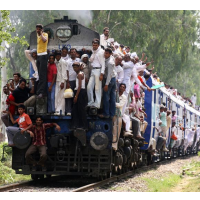Railway Budget a Test of Reform Resolve
 Freight revenues heavily subsidise passenger traffic in the Indian Railways
Freight revenues heavily subsidise passenger traffic in the Indian Railways
All eyes are on the railway budget to be unveiled on Thursday. It could show how far Prime Minister Narendra Modi is prepared to drive investment in a vital transport sector.
India's railway network is the world’s fourth largest, and may receive a 25 percent boost in investment to over $9 billion, funded solely by falling fuel costs. It could get even more if Modi makes it a priority, as China did during its rapid economic growth over the past two decades.
There are high hopes that the NDA government will plough money into investment in infrastructure needed to reenergise the economy when it presents its first annual federal budget on Saturday.
The rail budget is presented separately - a hangover from the colonial past – two days before the government’s budget.
According to sources quoted by Reuters, Railway Minister Suresh Prabhu has factored in savings from cheaper diesel totalling between Rs 120-150 billion ($1.9 billion-$2.4 billion) in the 2015/16 fiscal year that starts on April 1.
But he has also asked the finance ministry for an extra Rs 200 billion ($3.2 billion) to invest in track and rolling stock upgrades for a network that is used by 25 million passenger each day.
He is unlikely to get that much, though there is likely to be a significant increase in funding for the railways.
In 2014/15, Rs 454.5 billion ($7.3 billion) was budgeted for investment in the railway – with the government providing 66 percent and the rest coming from internal resources.
An increase in the budget allocation would go some way to offset disappointment at the lack of private sector interest in investing in railways, after the government last year suggested public-private partnerships for new routes.
As is usual in India, some lawmakers have made populist calls for the windfall from reduced diesel costs to be used to slash already heavily subsidised fares. But Prabhu is unlikely to pay much heed.
"There is no plan to cut passenger fares," a senior government official told Reuters.
Freight revenues already heavily subsidise passenger traffic in the Indian Railways, making it more expensive than road transport. But revenues from freight are expected to increase as the economy improves.
Providing jobs for 1.3 million people, the railway is India's largest single employer, and reform is politically sensitive. Successive governments have backed away from modernization, preferring instead to let the network chug along, providing cheap transport and jobs that are largely used as political largesse.
Years of under-investment, however, means that services are slow and plagued by frequent accidents. There are reportedly over 300 projects pending that need about Rs 1.8 trillion ($28.91 billion), including the installation of train protection warning systems and train collision avoidance systems.
The government’s challenge will be to find the funds to execute these long-term projects, while ensuring the railways improves its operational efficiency and safety record.
To Learn More:
India to embark on rail investment splurge thanks to cheap oil (by Manoj Kumar, Reuters)
Rail Budget: Privatisation key to modernising railways (by Bharat Salhotra, Financial Express)
Chinese Takeaway: Railway Lessons (by C Raja Mohan, Indian Express)
Exclusive! 'The Railways are bankrupt' (by Sheela Bhatt, Rediff.com)
God help the passengers of Indian Railways' high speed trains (by Sudheer Pal Singh, Business Standard)
- Top Stories
- Controversies
- Where is the Money Going?
- India and the World
- Appointments and Resignations
- Unusual News
- Latest News
- India College Chain’s Expansion into U.S. Draws Opposition from Massachusetts Officials over Quality of Education
- Milk Shortages in India Tied to Release of New Movies Featuring Nation’s Favorite Stars
- Confusion Swirls around Kashmir Newspaper Ban in Wake of Violent Street Protests
- Polio-Free for 5 Years, India Launches Vaccine Drive after Polio Strain Discovery
- New Aviation Policy Could Increase Service, Lower Ticket Prices






Comments